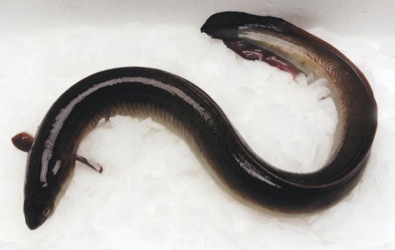
Eels: Lunch, Slip Sliding Away…
I can remember the first time I caught an eel. It was in the Royal River in Pownal Maine, using an earthworm on the bottom. Though perhaps only 10 miles from the sea as the crow flies the eel had followed the river inland for some 40 miles. But that’s what eels do.
I was a latchkey kid — probably why I spent so much time in the woods alone — and my mother was not at all happy to see 12-year-old me lugging home an eel. While her mother prized eels my mother did not. She said even when dead they wiggled when being cooked in the frying pan. No problem. I was already cooking for myself because my mother was a horrible cook. (I tell people she thought I was a Greek god. Every meal was either a burn offering or a sacrifice.) The eel I cooked tasted great.
 In a word, eels are fish,usually brown, green, olive or black, with a light or yellow stomach. There are five species in cooler waters, ten in warm waters, one in Europe. While they live in fresh water, on shallow bottoms, after a set number of years (8 for males, 13 for females, 25 if landlocked) their yellow belly turns silver and they swim to the deep Sargasso Sea between Bermuda and Puerto Rico. There they spawn and each female eel can produce as many as 10 million baby eels. The resulting little eels drift for a year upon the currents then select a fresh water area to live, from eastern North America to the rivers of western Europe. Thus my first eel had traveled several thousand miles. They’ve also been eaten around the world in nearly every country.
In a word, eels are fish,usually brown, green, olive or black, with a light or yellow stomach. There are five species in cooler waters, ten in warm waters, one in Europe. While they live in fresh water, on shallow bottoms, after a set number of years (8 for males, 13 for females, 25 if landlocked) their yellow belly turns silver and they swim to the deep Sargasso Sea between Bermuda and Puerto Rico. There they spawn and each female eel can produce as many as 10 million baby eels. The resulting little eels drift for a year upon the currents then select a fresh water area to live, from eastern North America to the rivers of western Europe. Thus my first eel had traveled several thousand miles. They’ve also been eaten around the world in nearly every country.
Eels live on the bottom and are are scavengers, like crabs and lobsters. Perhaps that contributes to their distinctive taste. They also eat small fish and mollusks. They are high in omega 3 fatty acids as well as vitamins A, B1, B2, D and E. Eels are about 71 percent water, 17% protein and 11 percent fat.
Catching eels depends on the time of year. The best time is when they head downriver to the sea to spawn. They are at maximum size and health then. And since they don’t all go every year there is always a migration. Eels usually travel at night in late summer and early autumn. In warm months they will take a baited hook. In the winter they can hibernate on the river or lake bottom often in great numbers (when they are taken by spears.) Young eels can be taken by baited hooks or traps. Here in Florida eels can live in canals, particularly in the southern end of the state.
Most commonly folks fish in estuaries from around 7 p.m. on using chicken liver, blood worms, squid strips even smelly old beef for bait. Eels prefer dead food. Cast about every two minutes into coves and shallower water where it runs in to deeper areas of the river. A fire on shore helps to attract them. A smaller hook works better than a larger hook. In turn you can use them for bait for larger fish, such as striped bass. Wait for a tug on the line, wait for a second tug then set the hook. I caught mine on a tiny gold hook intended for pan fish. And since the eel swallow the hook there was no possible compromise. My mother still complains about that first eel. After that she just gave up.
Once you have an eel you can dispatch it like other fish (they are slippier) or take it home and put it in deep container and toss in a cup of salt or so. Oddly that will kill them in a couple of hours and clean some of the slime away. Commercially eels are dispatched by putting them in a tank and stunning them with electricity. Eels must be thoroughly cleaned especially on the outside. All traces of slime must be removed. This can include scraping the skin. When gutting an eel (if you are not using the skin to cook it in) cut from just behind the head to the very end of its tail. Incidentally, eel skin is very tough and has been used to make door hinges.
To smoke cleaned eels, soak them in brine for 10 minutes (or more.) To make the brine use nine to 10 ounces of salt to a quart of water. Drain. Smoke at 95F /30C for one hour, the one hour at 120F/40C and finish with one hour at 170F/77C.
To can the same eels soak them in brine for 15 minutes. Then follow the same drying procedure. Afterwards pack them into a can, cover with a vegetable oil heated to 230F/110C and seal and heat process at 230F/110C. A seven ounce can takes one hour.
If you want to know how old the eels is it will tell you. Eels (and perch) have a bone under the gill cover. Remove it and count the rings. Just like a tree, one ring for each year alive. Oh, if you catch a Moray eel in tropical waters don’t eat it. It is best to consider it toxic to humans.
Eel Stifle
2 pounds peeled potatoes sliced thin
6 onions also peeled and sliced thin
2 pounds of eel cut into 3-inch pieces, or so
2 cups milk
1/4 pound salt pork diced
Flour
Salt
Pepper
Butter or oil a casserole large enough to hold everything. Put a third of the potatoes and onions on the bottom. Sprinkle with some flour, salt and pepper. Add a layer of eel, using half of them. Repeat the layer this time also adding half of the salt pork. Put the remaining potatoes and onions on top, sprinkle with the remaining salt pork. Add the milk. Cook in a preheated oven at 350F for an hour or so until tender. Should serve six, or one teenager.
Grilled Eel
2 pounds of eel
About a third of a cup of olive oil
Paprika, a pinch or two, or half a teaspoon
Sage, about 10 fresh leave chopped or less dried
Salt Pepper
Mix the seasoning with the oil. Let set for about 10 minutes. Meanwhile cut the eel in to three inch pieces. Wipe dry. Set the eel in the mix. Salt and pepper to taste. Heat broiler or start grill. Put eel on oven proof pan (four inches under broiler) or on grill. Cook 10 minutes. Turn pieces. Baste with mixture. Cook ten more minutes or until done (light golden brown.)
Jellied Eel
* 2 eels, cleaned, gutted and skinned (about two pounds)
* ¾ pint water
* 5 tbsp white wine vinegar
* 10 black peppercorns
* 1 bay leaf
* Salt
* Knob of butter
Chop the eels into pieces a couple of inches big
Grease a casserole dish with the butter
Put the eel pieces in the dish with the rest of the ingredients and season with the salt
Put the lid on the casserole dish and bake in the oven on gas mark 3, 170 c, 325 F for about an hour
Let the eel and its liquor cool before putting in the fridge over night until the liquid has ‘jellied’
Stewed Eel
* 2 eels, cleaned, gutted and skinned
* 1 pt fish stock
* 1 oz butter
* 2 tbsp milk
* 1 tbsp plain flour
* Salt and pepper
Chop the eels into 2 inch pieces
Melt the butter in a saucepan then add the flour, stir well and cook for a minute
Slowly add the stock and bring to the boil, stirring all the time
Add the pieces of eel and simmer for about an hour
Add the milk and salt and pepper to taste
Serve immediately with the sauce on the side
ENGLISH EEL PIE
Skin, clean, and cut up two large eels. Cook with one tablespoon of butter, half a cup of chopped mushrooms, a tablespoon of chopped parsley, a minced onion, a bay leaf, salt, pepper, the rind of a lemon, a wine glass of Sherry, and a cup of beef stock. Cook until the eels are tender, strain the sauce, and thicken with butter and flour. Line a baking dish with pastry, put the eels in it, and pour the sauce over, with sliced hard boiled eggs on top. Cover with pastry, brush with yolk of egg, and bake for an hour in a moderate oven. Serve either hot or cold.
EELS À LA LONDON
Fry four chopped onions in butter, dredge with flour, and cook thoroughly. Add two cups of stock, half a cup of Port wine, two bay leaves, and salt and pepper to season. Cook until thick, stirring constantly. Add one large cleaned eel, cut into two-inch lengths, cover, and cook for fifteen minutes. Serve on toast.
Achilles’ Eel
2 tb Olive oil
2 lb Eel cut into 3 inch pieces
1/2 lb Onions — roughly chopped
3 Sun-dried tomatoes (in oil) roughly chopped and soaked in
2 tb Boiling water or
1 tb Tomato paste instead
3/4 lb Tomatoes, skinned, seeded and chopped
1/2 ts Honey
1 tb Fresh thyme or
1/2 ts Greek “Mountain” thyme
1 Bay leaf crumbled
1 Zest of one lemon
1 tb Lemon juice
2 Garlic cloves, minced
1 cup Finely chopped flat-leaf parsley
1 tb Finely chopped fresh mint
1/2 lb Feta cheese, crumbled
Salt to taste
Freshly ground black pepper to taste
In a heavy skillet or wide flameproof casserole, heat 2 tablespoons olive oil and saute the eel pieces until are well-browned on all sides. Remove from the pan and add another tablespoon oil if necessary. Add the onions and fry gently until translucent. Pound the sun-dried tomatoes, if using, to a paste. Add to the pan with the chopped tomatoes, honey, thyme, bay leaf, lemon zest, and garlic and simmer for 10-12 minutes until the sauce begins to thicken. Return the eel pieces to the sauce and stir in the parsley, mint, and salt and pepper to taste. Move to a baking dish or earthenware casserole, if necessary. Strew with the crumbled feta and shake the dish, so the cheese settles a little. Sprinkle with lemon juice. Bake in an oven preheated to 350F for about 30 minutes.



Great Article!
I do have a question on the eels, I used to help my father dig drainage ditches for our slough in Southern Louisiana. There’s no flowing water to these as it’s cut off from the canals. When we were digging a few times something would come out of the mud (looking similar to the picture above) that was about 1 and a half to 2 ft long. my father called it an eel. Do you know of these, and are they edible as well? Even if they are I’m sure the saltwater purging would be needed to improve the taste considering stagnant swamp mud.
We, too, find the eels in mud. Are they any good? Thanks!